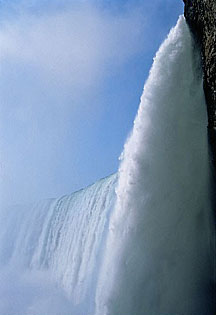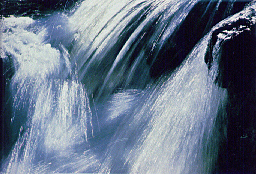Garry Black Photography Tips and Techniques |
||
WATERFALLS |
||
|
There is something about moving water that has a magnetic effect upon me. It has been with me for as long as I can remember. My earliest memories are of the North Sea at St. Andrews in Scotland, where I spent my summers. The sight and sounds of the crashing surf mesmerized me. There is something magical about moving water, it has the same effect that watching a lightning storm, a heavy rain or seeing a rainbow or large fluffy snowflakes has on us, it is the magic and wonder that Nature gives us. It evokes within us many opposing concepts and feelings: power, strength, fear, peacefulness, serenity, soothing, calmness. But there is something about waterfalls that makes us feel good, whatever this magic is, it is what lures people to waterfalls. Whether they are large, powerful ones like Niagara or Victoria Falls or small cascading brooks in a forest. Because so many people are drawn to waterfalls, they're one of the most photographed of all subjects. They're easy to find, but are also perplexing subjects to capture on film. | |
| There are as many different approaches to waterfall photography, as there are waterfalls. It all depends on the effect that you wish to create and the waterfall itself. Your personal preference as to how the water should look, is just exactly that, your own personal preference! One person may say it's better to shoot using longer exposure times to make the water look silky, while another may say shoot faster to stop the action. Neither approach is wrong nor are both right. Whichever style you choose, then obviously this is the proper one for you. If your choice is for a long exposure, then the exposure time should be at least 1/4 second or longer. Normally this will mean using a small aperture (f16 or f22), by doing this you achieve two goals. One, it allows for slower speed settings making the waterfalls look silky, and two, you get as much depth of field as possible, there by allowing the maximum amount of focus - depth of field- in your composition. | ||
| What makes photographing waterfalls tricky no matter which approach you choose, whether using short or long exposure times, is getting the proper exposure. Taking pictures of fast-moving water is quite different from shooting any other landscape. The white, bubbling water you see can fool your camera's meter as easily as snow does. How often have you gotten back slides of underexposed waterfalls and winter landscapes? |
|
|






